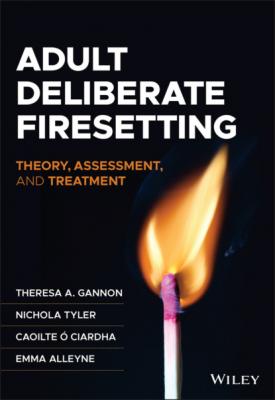Adult Deliberate Firesetting. Theresa A. Gannon
Читать онлайн.| Название | Adult Deliberate Firesetting |
|---|---|
| Автор произведения | Theresa A. Gannon |
| Жанр | Социальная психология |
| Серия | |
| Издательство | Социальная психология |
| Год выпуска | 0 |
| isbn | 9781119658153 |
Dalhuisen et al. (2017), set out explicitly to assess the trajectories of the M-TTAF using all individuals referred to a single clinic in the Netherlands over a period of over 60 years for pretrial assessment following a suspected firesetting offence. They reported that their participants appeared to cluster into five groupings. Dalhuisen et al. (2017) interpreted their findings as partially supporting the hypothesised M-TTAF trajectories. Perhaps more important for the focus of the current chapter, their findings appear to evidence considerable variability within samples of individuals who have set fires in terms of developmental (history of abuse), psychopathological (psychosis), and psychological (empathy, impulsivity, coping, and social skills) characteristics.
Limitations of the Literature and the Current Review
In summarising the literature, we have attempted to give greater weight to high-quality empirical sources as well as high-quality reviews synthesising the existing literature. Despite these aims, we have also relied in places on less robust studies, especially where those studies are more recent and have not been incorporated into past reviews.
A limitation of the adult firesetting literature to date has been the lack of comparison groups or the use of only one comparison group. As a result, it is not always possible to examine what differentiates individuals who have set fires from the wider community and from other justice-involved individuals. Additionally, the literature on adult firesetting has often focused on individuals who have a mental disorder and a history of firesetting. Given the theoretical and empirical links between psychopathology and firesetting, this focus is unsurprising. However, the sampling of individuals with a mental disorder or those without also likely reflects a pragmatic decision in terms of the population to which researchers have had access. As a result, studies of institutionalised individuals have often focused on just one type of institutional setting, either prison (e.g., Ó Ciardha et al., 2015a) or secure mental health (e.g., Wyatt et al., 2019). We have attempted to bring together the results of these studies in reviewing the available literature in this chapter and are most confident in results that appear consistent across settings.
Most psychological research on the characteristics or clinical features of individuals who set fires has been conducted in so-called WEIRD countries (i.e., Western, educated, industrialised, rich and democratic), particularly majority Anglophone as well as countries in the north of Europe. Research has focused less on a global picture of this phenomenon. Additionally, research conducted in WEIRD countries has not typically disaggregated findings to examine the generalisability of findings to ethnic minorities or indigenous populations within those countries. One exception to this trend was a recent study by Ellis-Smith et al. (2019), which examined differences in some offence characteristics (and criminal justice system outcomes) between Aboriginal and non-Aboriginal Australians who had set fires. Gannon et al. (2012) highlighted how cross-cultural differences in the use of fire and of education in its use may need to be accounted for in models of deliberate firesetting. This cross-cultural perspective remains lacking from much of the research summarised in this chapter.
Conclusions, Ways of Working, and Future Directions
Our review of the literature on the characteristics of individuals who have set deliberate fires as adults demonstrates a field that has expanded considerably in the past decade. There are clearly still gaps in our knowledge, and there remains a need for large representative studies and replication of older findings. However, the cumulative evidence appears to confirm that individuals who set fires reflect a population that—when considered in aggregate—have characteristics that set them apart from the general population across early developmental, psychopathological, and psychological domains. When compared with other justice-involved individuals, people who set fires appear to be broadly similar in terms of their sociodemographic and early developmental characteristics but may have specific vulnerabilities, risk factors, or treatment needs relating to their psychological and psychopathological characteristics.
We are encouraged by a growing move beyond examining the characteristics of homogenised groups of individuals who set fires towards examining the characteristics of subgroups of firesetting individuals. Given that the expansion of the literature that we note in this chapter, we believe that there is increasing scope to take a meta-analytic approach to synthesising knowledge on the characteristics of people who set fires. We strongly encourage practitioners and people working with populations of people who have set fires to routinely embed measures (e.g., Gannon et al., in preparation) of the psychological characteristics most clearly linked with firesetting behaviour in their assessment procedures. Doing so will help provide the foundation for future work on theory, assessment, and treatment of this population.
Конец ознакомительного фрагмента.
Текст предоставлен ООО «ЛитРес».
Прочитайте эту книгу целиком, купив полную легальную версию на ЛитРес.
Безопасно оплатить книгу можно банковской картой Visa, MasterCard, Maestro, со счета мобильного телефона, с платежного терминала, в салоне МТС или Связной, через PayPal, WebMoney, Яндекс.Деньги, QIWI Кошелек, бонусными картами или другим удобным Вам способом.
